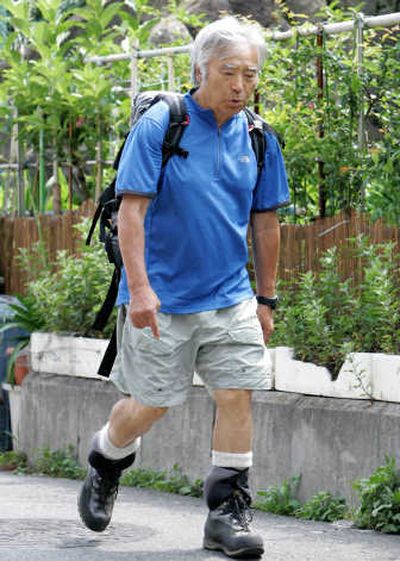Health, wealth push aging Japanese climbers

TOKYO – Yuichiro Miura has an unusual routine for a man who just turned 75.
At dawn, the veteran adventurer wakes after a night in a private low-oxygen chamber. He straps weights onto his ankles, hoists a 44-pound backpack onto his shoulders and hikes for hours around Tokyo. Sometimes he adds a stroll on his treadmill.
Ask Miura why he isn’t on the golf course or puttering around a vegetable garden, and he has a simple answer – Mount Everest.
Miura is one of Japan’s old men of the mountain, a small cluster of graying climbers who since 2002 have been passing among themselves an august title: the oldest person to have conquered the world’s tallest peak.
“It’s a tough but wonderful thing to get to the peak when you are past 70,” Miura said at his Tokyo home. “I hope to send the message that we have the potential for many things in this aging society.”
Miura is already famous for having skied down Everest in 1970, a feat captured in an Oscar-winning documentary. Now, for seniors like him, climbing the 29,035-foot Himalayan peak is as extreme an elderly activity as there is.
It’s no wonder that the Japanese have cornered the market in elderly Everest conquerers. The country has the world’s longest-living population and is going through a boom in activities for the elderly.
Toshio Yamamoto started the string of Japanese victories by scaling the peak in 2000 at 63 years. In 2001, American climber Sherman Bull reached the summit at 64 years old. Tomiyasu Ishikawa, then 65, took the title in 2002.
Miura won the distinction in 2003, at 70, but was eclipsed by fellow Japanese climber Takao Arayama, who scaled the peak in 2006, just three days older than Miura was when he did it. Katsusuke Yanagisawa took the crown this year, at age 71 years and 63 days.
Now Miura wants to reach the top again.
“It feels like the goddess of Everest is beckoning me to come back,” said Miura, who plans an assault on the mountain next spring, when he’ll be 75 (Edmund Hillary was 33 when he became the first man to climb Everest, in 1953). None of three other Japanese record-holders plans to scale the mountain again, they say.
The Japanese also hold the record for oldest woman on Everest: Tamae Watanabe in 2002, at age 63.
Some attribute the prevalence of Japanese adventurers among the ranks of older climbers to the same factors that make them live increasingly longer: a diet heavy in vegetables and fish, excellent health care and trim physiques.
Another factor is increasing affluence.
The spread of commercial expeditions beginning in the early 1990s allowed inexperienced but rich climbers to reach the summit.
Arayama, who broke Miura’s record when he scaled the peak in 2006, said climbing Everest was a remote idea in his 20s, when the science was undeveloped and the experience was not widely open to the general public.
“The way we climb has changed. You use oxygen so you won’t tire yourself, and more was found out about the best pace of climbing, and that’s why I got to climb,” he said.
Miura’s climb is estimated to cost $1.7 million, including overseas training trips and $515,000 for the May expedition, which includes expenses for his climbing companions as well as communication and video recording costs. The effort is supported by corporate giants including Toyota Corp. and Toshiba Corp.
Miura has built a $260,000 low-oxygen room inside his Tokyo home to help him acclimatize to the thin air. A large photograph of Everest looms over his stationary bike machines and treadmill.
Miura says setting a record isn’t all that important, since someone else will surely come along and break it. Instead, he said, “it’s about discovering what I can do.”